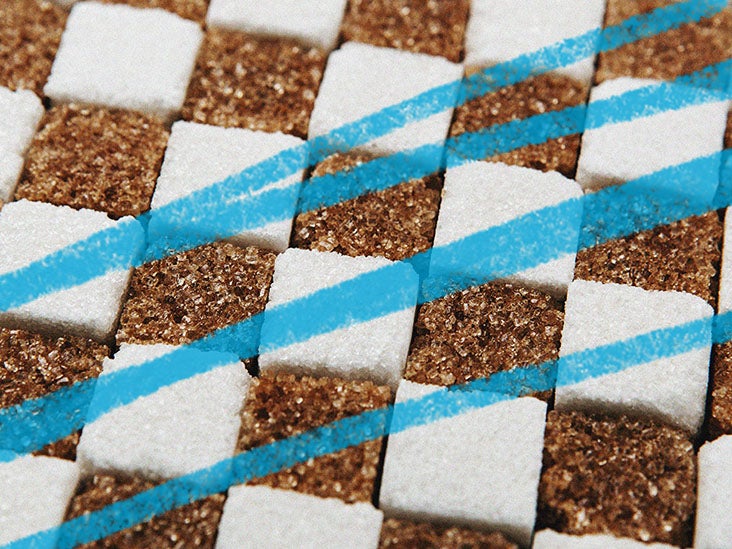
Nutritionally speaking, white sugar and brown sugar are similar. However, both feature contrasting tastes and properties that give them different functions as ingredients. Additionally, sugar is a food low in beneficial nutrients, so people should limit their sugar intake to occasional treats.
There are many different types of sugar available for purchase, making it challenging to know which is best for certain foods or recipes.
Brown and white sugar have different flavors and textures, while recipes often call for a specific type. Substituting another kind of sugar can change the overall texture and taste of a dish.
This article explores the nutritional differences between white and brown sugar. It also examines how manufacturers make each type, and discusses which type is best for baking and using in foods and drinks. Finally, it offers more nutritious alternatives.
White and brown sugar contain similar calories. Brown sugar contains 380 calories per 100 grams (g), while white sugar contains 385 calories per 100 g.
Brown sugar contains more calcium than white sugar, with 83 milligrams (mg) per 100 g compared to 1 mg per 100 g of white sugar. Equally, other minerals, such as iron, are slightly higher in brown sugar.
However, per teaspoon, the tiny differences in these mineral amounts are not worthy of consideration, as sugar is not a nutrient-dense food. People refer to foods such as these as “empty calories.”
The Dietary Guidelines for Americans advises people to limit added sugars to 10% of their daily calories to help avoid excess weight and reduce the risk of chronic diseases. This means that if a person consumes 2,000 calories a day, no more than 200 of them should come from added sugar, equating to about 12 teaspoons.
Learn more about the nutrition of added sugar.
Risks of eating too much sugar
The Centers for Disease Control and Prevention (CDC) state that eating too much added sugar can increase a person’s risk of potentially serious health conditions, such as:
The Sugar Association explains that manufacturers make all sugar by extracting sugar juice from sugar beet or sugar cane plants. The production process involves cleaning, crystallizing, and drying the raw sugar.
During the production process, manufacturers separate sugar crystals from molasses, a thick, dark brown syrup naturally present in sugar beet and sugar cane.
Sugar cane molasses feature a sweet flavor, but sugar beet molasses are not very sweet, and manufacturers use this for animal feeds and other industries. The amount of molasses determine the color, flavor, and moisture content of sugar. Having more molasses gives this food a richer color and flavor.
Manufacturers can also boil brown sugar syrup to produce brown sugar.
By varying the size of the crystals and the quantity of molasses, food companies can make sugars suitable for different foods, drinks, and recipes.
The Sugar Association offers information about which types of white and brown sugars are more suitable for certain foods and recipes.
White sugar types
- Granulated sugar: People typically use granulated sugar in their sugar bowls for hot drinks or baking.
- Superfine or caster sugar: This type of sugar has smaller crystals, making it helpful in preparing delicate desserts such as mousse or puddings.
- Confectioners or powdered sugar: This fine, granulated sugar comes from sugar that manufacturers grind and sift. People use it in sweets, icing, and whipping cream.
- Fruit sugar: Smaller, more uniform crystals comprise fruit sugar, making it more suitable for dry mixes, pudding desserts, and powdered drinks.
Brown sugar types
Brown sugars tend to clump because they contain more moisture than white sugar. This makes it helpful in recipes requiring a moist and chewy texture.
- Light brown sugar: This is suitable for baked goods and sauces.
- Dark brown sugar: Features a deeper color than standard brown sugar. In addition, the molasses flavor makes it suitable for use in gingerbread recipes, baked beans, and barbecued foods.
- Muscovado sugar: This is unrefined cane sugar that still contains its natural molasses. As a result, the crystals are slightly coarser and stickier than regular brown sugar, and people can use them in recipes that require a strong molasses flavor.
- Turbinado sugar: Features a blond color and a mild flavor. Manufacturers only partially process turbinado sugar, which they also call demerara or raw cane sugar. It has larger crystals than brown sugars and is more suited to streusel toppings than baking.
The CDC reports that people in the United States are generally eating too much added sugar.
Both white and brown sugars are not a nutritious addition to the diet. Therefore, they should limit their intake of added sugars as part of a balanced, nutritious diet. This includes avoiding excessive use of syrups, honey, and concentrated fruit juices.
More nutritious alternatives that someone could consider using in foods, drinks, and recipes include the following:
Learn more about sugar alternatives.
Although honey and maple syrup are natural sugars, they may still lead to excess weight and increase the risk of chronic diseases if someone consumes too much of them. However, using honey and maple syrup in small quantities occasionally may be a more natural alternative to processed sugar, as research has indicated they contain some beneficial nutrients and antioxidants. However, these benefits are likely minimal and will not provide much of a health benefit.
Brown sugars may be better than white sugar for baking recipes that call for a richer flavor or a more moist and chewy texture. In these cases, muscovado sugar, with its higher molasses content, has the most pronounced flavor.
However, because sugar is a food low in beneficial nutrients, the U.S. government advises that people limit their added sugar consumption to 10% of their daily calories. Individuals looking to make sweet foods can try nutritious alternatives, such as erythritol or stevia, or use mashed fruit or cinnamon in baking.
from WordPress https://ift.tt/3h8DXpE
via IFTTT
Comments
Post a Comment